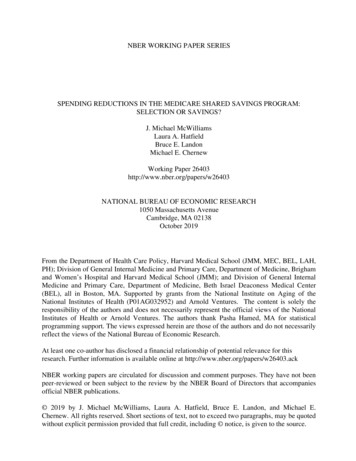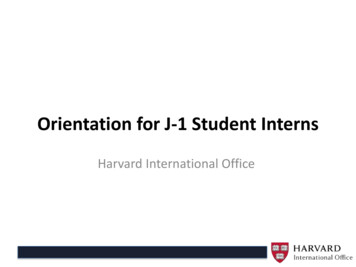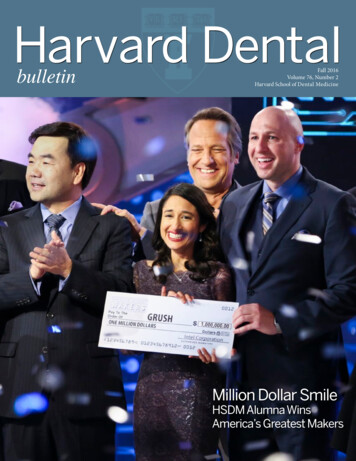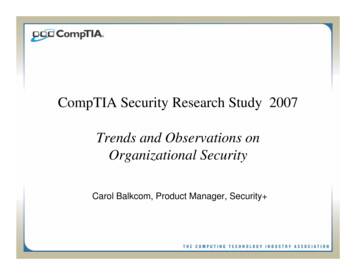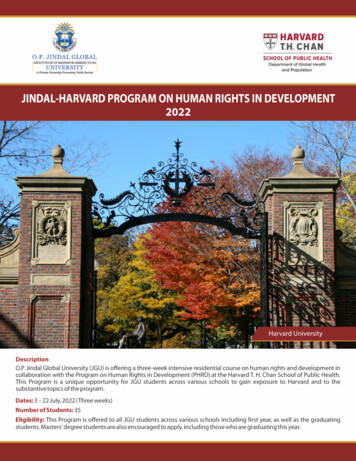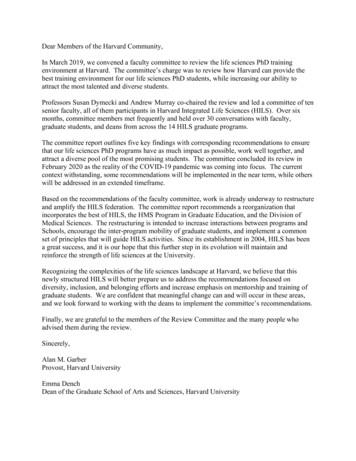
Transcription
Dear Members of the Harvard Community,In March 2019, we convened a faculty committee to review the life sciences PhD trainingenvironment at Harvard. The committee’s charge was to review how Harvard can provide thebest training environment for our life sciences PhD students, while increasing our ability toattract the most talented and diverse students.Professors Susan Dymecki and Andrew Murray co-chaired the review and led a committee of tensenior faculty, all of them participants in Harvard Integrated Life Sciences (HILS). Over sixmonths, committee members met frequently and held over 30 conversations with faculty,graduate students, and deans from across the 14 HILS graduate programs.The committee report outlines five key findings with corresponding recommendations to ensurethat our life sciences PhD programs have as much impact as possible, work well together, andattract a diverse pool of the most promising students. The committee concluded its review inFebruary 2020 as the reality of the COVID-19 pandemic was coming into focus. The currentcontext withstanding, some recommendations will be implemented in the near term, while otherswill be addressed in an extended timeframe.Based on the recommendations of the faculty committee, work is already underway to restructureand amplify the HILS federation. The committee report recommends a reorganization thatincorporates the best of HILS, the HMS Program in Graduate Education, and the Division ofMedical Sciences. The restructuring is intended to increase interactions between programs andSchools, encourage the inter-program mobility of graduate students, and implement a commonset of principles that will guide HILS activities. Since its establishment in 2004, HILS has beena great success, and it is our hope that this further step in its evolution will maintain andreinforce the strength of life sciences at the University.Recognizing the complexities of the life sciences landscape at Harvard, we believe that thisnewly structured HILS will better prepare us to address the recommendations focused ondiversity, inclusion, and belonging efforts and increase emphasis on mentorship and training ofgraduate students. We are confident that meaningful change can and will occur in these areas,and we look forward to working with the deans to implement the committee’s recommendations.Finally, we are grateful to the members of the Review Committee and the many people whoadvised them during the review.Sincerely,Alan M. GarberProvost, Harvard UniversityEmma DenchDean of the Graduate School of Arts and Sciences, Harvard University
REPORT AND RECOMMENDATIONS OF THE LIFE SCIENCESPH.D. REVIEW COMMITTEEHARVARD UNIVERSITYJune 2020
TABLE OF CONTENTSINTRODUCTION . 1HARVARD LIFE SCIENCE PH.D. PROGRAMS . 3COMPARISON WITH PEER PH.D. PROGRAMS . 4FINDINGS & RECOMMENDATIONS . 5Findings & Recommendations 1: Administration of Life Science Ph.D. Programs. 5Findings & Recommendations 2: Diversity, Inclusion, and Belonging. 8Findings & Recommendations 3: Financial Support . 9Findings & Recommendations 4: Education, Mentorship, & Training. 12Findings & Recommendations 5: Celebrating and Empowering Graduate Students15ACKNOWLEDGEMENTS . 16APPENDICES . 17Appendix A: Charge of the Life Sciences Ph.D. Review Committee . 18Appendix B: Recommendations for Revision of HILS and Program Websites . 20Appendix : Example Mentor-Student Compact . 21
Introduction: Charge, Rationale, Composition, Process, ContentThe Life Sciences Ph.D. Review Committee was convened by Provost Alan Garber and Dean EmmaDench, with the support of the Deans of HMS, FAS, and the Science Division within FAS, in May of2019.Charge: The committee was charged with investigating the competitiveness of our Ph.D. programs, theirorganization, structure, and funding, and how to ensure programmatic focus on the training, well being,and future careers of our students. The formal charge is included as Appendix A.Rationale: The rationale for a focused review of life sciences Ph.D. programs was the result of a previousexternal review in 2015 of the life sciences across the University, including HMS, FAS, and HSPH.Graduate education in the life sciences was a major topic of interest to the 2015 University-wide LifeSciences Review Committee. It recommended that Harvard take a closer look at the structures establishedfor the recruitment, admission, and training of graduate students in the life sciences Ph.D. programs,recognizing their important contributions to research, education, and faculty recruitment and retention inthe life sciences at Harvard.In response to this recommendation, two reviews ensued in 2017: the Provost’s Office and GSAS workedto conduct a high-level review of the Harvard Integrated Life Sciences Program, and HMS conducted areview of its Program in Graduate Education. Both reviews pointed to the need for Harvard to re-examinewhat factors will ensure that the University will remain attractive to the best, most talented and diversegroup of graduate students in the life sciences, and allow Harvard to be competitive with its peerinstitutions in recruiting and training them.Composition: The committee consisted of faculty who serve or who have served as a director of one ofthe Harvard Life Sciences Ph.D. Programs:Susan Dymecki (Chair)Professor of GeneticsDirector, Ph.D. Program in Biological and Biomedical SciencesHarvard Medical SchoolAndrew Murray (Chair)Herchel Smith Professor of Molecular GeneticsProfessor of Molecular and Cellular BiologyCo-Director, Systems, Synthetic and Quantitative Biology Ph.D. ProgramHarvard University Faculty of Arts and SciencesTom BernhardtProfessor of MicrobiologyAssociate Director, Ph.D. Program in Biological and Biomedical SciencesHarvard Medical SchoolVictoria D’SouzaProfessor of Molecular and Cellular BiologyCo-Director of the Molecules, Cells, and Organisms Ph.D. ProgramHarvard University Faculty of Arts and SciencesMichael Desai1
Professor of Organismic and Evolutionary BiologyProfessor of PhysicsCo-Director of Organismic and Evolutionary Biology Graduate StudiesHarvard University Faculty of Arts and SciencesSean EddyEllmore C. Patterson Professor of Molecular and Cellular BiologyProfessor of Applied MathematicsHarvard University Faculty of Arts and SciencesWendy GarrettProfessor of Immunology and Infectious DiseasesAssociate Director of the Ph.D. Program in ImmunologyHarvard T. H. Chan School of Public HealthAssociate Professor of MedicineHarvard Medical SchoolDan KahneHiggins Professor of Chemistry and Chemical Biology and of Molecular and Cellular BiologyCo-Director Chemical Biology Ph.D. ProgramHarvard University Faculty of Arts and SciencesProfessor of Biological Chemistry and Molecular PharmacologyHarvard Medical SchoolRandy KingHarry C. McKenzie Professor of Cell BiologyHarvard Medical SchoolBrendan ManningProfessor of Molecular MetabolismDirector of the Ph.D. Program in Biological Sciences in Public HealthHarvard T.H. Chan School of Public HealthPeter ParkProfessor of Biomedical InformaticsDirector of the Bioinformatics and Integrative Genomics Ph.D. ProgramHarvard Medical SchoolRachel WilsonMartin Family Professor of Basic Research in the Field of NeurobiologyHarvard Medical SchoolWe were supported by Emily Vetter and Camille Gladieux from the Provost’s Office.2
Process: Following the initial meeting with the provost and GSAS dean in May 2019, the Life SciencesPh.D. Review Committee held bi-weekly meetings from August 2019 to January 2020. The committeeincluded membership from the Faculty of Arts and Sciences (FAS), the Paulson School of Engineeringand Applied Sciences, the Harvard Medical School (HMS), and the Harvard T.H. Chan School of PublicHealth (HSPH). Over six months, we met with key stakeholders in Harvard life sciences graduateeducation, including: Harvard’s Provost, Deans of GSAS, FAS and HMS, the HMS Dean for GraduateEducation, the FAS Dean for Science, the leaders of Harvard Integrated Life Sciences (HILS), DMS, andthe HMS Program in Graduate Education, Dean for Diversity and Academic Programs, financial officersfrom HMS, FAS, and GSAS, graduate program directors, junior faculty, and graduate students from the14 HILS graduate programs including student HGSU-UAW representatives.Throughout its work, the committee was guided by two key principles. First, that graduate students areessential to the University and, in many ways, represent the core of our research mission by contributingvitality necessary for success in innovation and discovery. Second, that the opportunity for life sciencesgraduate students to study across programs at Harvard is essential and should not only be sustained butstrengthened.In our findings and recommendations below, we address competitiveness and admissions yields,organization and governance for the life sciences, and student-centric training and support. Therecommendations that follow are designed to strengthen the connections between programs and bolstermechanisms for sharing of best practices. Many are inspired by exemplary practices already in placesomewhere at Harvard.This report was prepared when there appeared to be a reasonable possibility that Covid19 could becontained as a pandemic in a small number of countries and thus that the global financial climate might beassumed to be reasonably stable. Now, we are in the midst of a global pandemic and economic recession,placing severe financial burdens on institutions, like Harvard, which depend heavily on endowmentincome to support graduate students. We acknowledge that this will make it hard to implement thereport’s recommendations on the initially hoped-for timescale.Report content and organization: The report begins with a description of the 14 life science Ph.D.programs at Harvard including their organization, continues with a comparison among our programs andthose at our peer universities, and concludes with findings and recommendations for our graduateprograms in five areas: 1) structure and administration; 2) diversity, inclusion, and belonging; 3) fundingand financial structure; 4) education, mentorship, and training; and 5) celebrating and empowering ourgraduate students. For each area, we offer a vision, describe problems that prevent achieving the vision,and propose solutions.Harvard Life Science Ph.D. ProgramsLife science graduate education at Harvard is comprised of 14 Ph.D. programs of study across fourHarvard faculties—Harvard Faculty of Arts and Sciences, Harvard T. H. Chan School of Public Health,Harvard Medical School, and Harvard School of Dental Medicine. These 14 programs make up theHarvard Integrated Life Sciences (HILS). Although the individual programs may be administered andfunded by one school, the students in each of the HILS programs work in laboratories across the fourschools and the Harvard hospitals. The Graduate School of Arts and Sciences, within the Faculty of Artsand Sciences, oversees the admissions and grants degrees for all Harvard Ph.D. programs.Harvard Life Science Ph.D. Programs include:3
Administered and funded by the Harvard T.H. Chan School of Public HealthBiological Sciences in Public Health (BPH)Administered and funded by the Faculty of Arts and SciencesChemistry and Chemical Biology (CCB)Molecules, Cells, and Organisms (MCO)Organismic and Evolutionary Biology (OEB)Administered by the Faculty of Arts and Sciences; funded by the Faculty of Arts and Sciences and theHarvard Medical School (referred to as the cross-river programs).BiophysicsChemical BiologySystems, Synthetic, and Quantitative Biology (SSQBio)Administered and funded by the Harvard Medical SchoolBioinformatics and Integrative Genomics (BIG)Biological and Biomedical Sciences (BBS)ImmunologyNeuroscience (PiN)Speech and Hearing Bioscience and Technology (SHBT)VirologyAdministered and funded by the Harvard School of Dental MedicineBiological Sciences in Dental Medicine (BSDM)Comparison with Peer Ph.D. ProgramsAs part of the charge to our committee, we were asked to compare Harvard’s life science Ph.D. programsas a whole to our competitors, including MIT, Stanford, UCSF, etc. We relied on several key sources ofdata for this information: data published by the Coalition for Next Generation Life Science, surveys ofHarvard graduate students in the HILS Ph.D. programs conducted by Jason Heustis, HMS Director ofStudent Development and Training Evaluation, and information provided to our committee by the HILSprogram director, Grace Gill. The main points of comparison with other university life science graduateprograms were admissions rate (selectivity) and yields, median time to degree, and financial support. Inaddition, the co-chairs of our committee conducted interviews with multiple groups of graduate studentsfrom HILS programs to hear their thoughts on how the graduate student experience could be improved atHarvard.Findings: As was concluded in the 2018 HILS Review, Harvard’s life science programs are competitiveagainst peers in many dimensions. While there is variation from program to program, and over timewithin individual programs, our overall yields and admission rates are well within the range of our peerschools. Similarly, across HILS, the median time to degree is slightly less than our peers.Previous examination by HILS, and further investigation by this committee, shows that stipends atHarvard are comparable to other schools. In some cases, a straightforward dollar comparison of stipendsis misleading as some of our peers offer a higher stipend but then charge fees that are covered inHarvard’s financial package for students.4
In surveys of current and prospective students, most students report choosing a Ph.D. program for reasonsrelated to their academic goals. Differences in financial aid packages were rarely the major reason.Findings & RecommendationsFindings & Recommendations 1: Administration of Life Science Ph.D. ProgramsThe diversity and growth of the life sciences and the blurring of disciplinary boundaries within biologyand between biology and other natural sciences creates new challenges for major research universities,especially those with affiliated medical schools: a single biology graduate program would be extremelybroad and unmanageably large, whereas, individual more narrowly focused graduate programs can createbarriers to interdisciplinary research, stifling students whose scientific goals are interdisciplinary.VisionThis structural dilemma can be solved by creating a unified, efficient, and nimble governing structure thatspans the life science Ph.D. programs, benefitting from economies of scale and shared intellect yetsupporting field-related differences between programs. The organization should ensure equity acrossgraduate programs while allowing the strengths of individual programs to shine and attract the strongestand most diverse student body. The structure should increase interactions across programs and schools,acknowledging that innovation often lies at interfaces between disciplines, maximize the inter-programmobility of students, and adopt a common set of principles that will guide flexible and effectiveadministration. We envision extending this organization to the other natural sciences at Harvard,facilitating the sharing of best practices, the education and training of our students, and promotinginterdisciplinary science. This structure and the interactions that it fosters will strengthen graduateeducation in the life sciences at Harvard.ProblemsWe are not the first review committee to argue for an integrated administration of the life science Ph.D.programs across schools (FAS, HMS, HSPH, and HSDM), which each fund graduate programs. In 2004,a faculty committee charged with unifying the graduate programs in the life sciences made a similarargument in its report on the future of science and engineering at Harvard. Their recommendation led tothe creation of HILS, the Harvard Integrated Life Sciences Program, which shares best practices amonggraduate programs and increases student mobility between graduate programs. Given its modest budget,limited staff, and lack of administrative authority, HILS has been a remarkable success. Our studentsperceive Harvard as having an integrated and accessible life science community. Many students arementored by faculty who are not affiliated with the program that admitted them, and program directorsmeet to share best practices and discuss ways to better support our students. Yet achieving fullcoordination among programs remains a recurring challenge, as does competition between programs forour students.At HMS, the Program in Graduate Education (PGE) was founded to augment HILS, help address theseissues in the Longwood-based and cross-river programs, and improve the education and training ofgraduate students. PGE has used the HMS Curriculum Fellows Program (CFP) – a program comprised ofpostdoctoral fellows training in science pedagogy and augmenting curricular efforts and innovations byHMS faculty. The Division of Medical Sciences (DMS) at HMS, yet a third governing body (HILS, PGE,and DMS), administers six of the seven Longwood-based life science Ph.D. programs.5
There are two other Longwood-based life science programs: the Biological Sciences in Public HealthProgram at the Harvard T.H. Chan School of Public Health and the Ph.D. Program in Biological Sciencesin Dental Medicine at the Harvard School of Dental Medicine (HSDM).The relationships among HILS, PGE, and DMS are complex, organizationally and politically. Of thesethree groups, only DMS – working with the HMS administration– has been authorized to set the size ofindividual graduate programs and appoint their directors. None have been authorized to discipline faculty,to mandate training for faculty who seek to mentor students, nor to promote interactions with the physicalsciences and mathematics. Thus problems persist around coordination, internal competition to recruitstudents, meaningful interactions between programs and disciplines, accountability, accessibility, andpublic and internal perceptions.SolutionsWe propose a reorganization that amalgamates the best of HILS, PGE, and DMS to create a new structurekeeping the HILS acronym but reinvented and empowered through the following steps:1. The new HILS should be jointly governed by two individuals, the Dean for Graduate Education atHMS and a newly created FAS appointment of a Dean for Graduate Education in the Natural Sciences.Just as the HMS Dean for Graduate Education oversees all life science PhD and Master’s degreeprograms at HMS, the FAS appointed Dean for Graduate Education in the Natural Sciences would beresponsible for all graduate programs in the FAS Division of Science. These two deans (HILS Codirectors) should comprise a facile team that meets frequently to effectively “weave one fabric” thatsupports Ph.D. education in the natural sciences at Harvard across campuses. This would include meetingregularly and jointly with the GSAS, HMS, and FAS-Science Deans, who, in addition to advising wouldalso adjudicate any differing views between the two Deans for Graduate Education. These two deanswould also meet regularly and jointly with a steering committee composed of the GSAS Dean forAcademic Programming and Diversity, the Administrative Director of HILS, the Associate Dean forGraduate Education at HMS, the Director of Student Development and Training Evaluation at HMS, theHSPH Dean for Education, and the directors of the fourteen life science graduate programs – ensuringprogram representation for HSPH, HSDM, HMS, and FAS. To help build stronger links with SEAS, werecommend that a member of the SEAS faculty serve on the HILS Steering Committee in a non-votingrole.2. The respective HILS Co-Director would administer efforts around support for training grant andindividual fellowship applications and other student and programmatic responsibilities, with the HMSHILS Co-Director managing the Longwood-based programs, the FAS HILS Co-Director for the FASbased programs, and a unified management for the cross-river programs. For scale and efficiency, studentservices, such as assistance with fellowship proposals, for the Ph.D. Program in Biological Sciences inPublic Health, which lies outside of HMS and FAS, would be supported by HMS-HILS given thephysical proximity and programmatic affinity. These services would be supported by an agreed upon perstudent financial transaction from HSPH to the HILS-HMS budget. The Biological Sciences in DentalMedicine Program at HSDM, a dual DMD/PhD Program, should be integrated with the HMS MD/PhDProgram given its small size and need for a broader community and comprehensive student support fordual degree training.3. The individual life science graduate programs and their directors would report to the HILS CoDirectors. Individual, program-generated innovations would be encouraged by this structure, and,depending on their scale, would involve consultation with one or both HILS Co-Directors.4. Overall targets for student recruitment would be set by the Deans for GSAS, HMS, HSPH, and FASscience in coordination with the HILS Co-Directors. The HILS Co-Directors would apportion slots to the6
individual Ph.D. programs under their respective purview; the Dean for HSPH would apportion BPHprogram slots.5. The PGE would be incorporated as an integral part of the new HILS, as its members are a subset of thenew HILS Steering Committee, and its mission is shared. Existing PGE activities would be overseen bythe HILS Co-Directors and HILS Steering Committee. Curriculum Fellows would be appointed in FAS inaddition to the program at HMS and be jointly managed through the existing HMS Curriculum FellowsProgram (CFP) administrative structure. The FAS-based fellows would be funded by GSAS, FAS, and itsdepartments. Meetings and events directed towards students and program directors will occur in bothCambridge and Longwood, but the overall administration of the CFP would remain based at HMS.6. A significant portion of the HILS budget would come from central University resources and mustinclude funding for student migrations and student emergencies (essential to recruitment, success, andwell being of our students), tools and technology for students such as computers (essential to ensuring thesuccess of all of our students, regardless of their means), and resources to support professional/careerdevelopment, including support for science-related student internships in not-for-profit entities.7. HILS must redesign its web presence to reflect this new organizational structure and to better supportexisting students and new applicants. The current website is difficult to navigate and poorly integratedwith GSAS webpages, where students apply to Harvard Ph.D. programs. A single portal should allowone-click access to a concise introductory page for HILS and for each constituent graduate program,whose layout is unified and provides information on the program, faculty, resources and funding, coursework, diversity and inclusion, and student life. HILS and its constituent graduate programs should eachassess their own websites to create a more accessible, user-friendly, and up-to-date experience. The policyon fee waivers for applications should be clear, liberal, and avoid embarrassing those applicants in need.The policy on number of programs and times an applicant may apply to Harvard GSAS should be clearlydescribed and set at up to two HILS life science program applications in any given year and a total of upto four applications to individual programs over up to three admission cycles. Please see further detail inAppendix B.8. HILS should commission external reviews of each of its constituent graduate programs every five yearsand should be prepared to recommend the closure of programs for any of the following reasons:uncompetitive student recruitment, persistent problems in student satisfaction and retention, and financialdifficulties.9. HILS should use a three-year model for setting admissions targets, to avoid the need to continuallyadjust to the effects of statistical fluctuations in student yield in the preceding admission cycle. Thiswould allow for multi-year planning, as opposed to risking under-yielding every year to meet annualbudget constraints. This would also allow for phasing in of changes in slot allocation across programs as aresponse to a strategic plan. The practice of sharing application information between programs so thatstudents are only admitted to a single program should stop. Our goal is to recruit the best students toHarvard and admissions targets should reflect the reality that some of our best applicants are admitted tomultiple programs. The effect of multiple admissions on the yield of individual programs should beconsidered in evaluating their performance and in allocating slots.10. The two Deans for Graduate Education should work to catalyze interactions and build stronger linkswith the physical, applied, and engineering sciences at Harvard and the statistics- and population sciencebased programs at HSPH, so as to support the interdisciplinary directions of contemporary bioscience andto facilitate sharing of best practices in graduate student training and mentorship.7
Findings & Recommendations 2: Diversity, Inclusion, and BelongingFor much of its history, science has been overwhelmingly white and male. We recognize that every aspectof diversity benefits science and that the absence of role models, at every career stage, discourages a widerange of students from pursuing careers in science.VisionThe University must take steps to recruit, mentor, and fully support a maximally diverse population ofgraduate students and the faculty who mentor and advise them. Faculty role models are essential toachieving this mission. By 2030, our students, and by 2040, our faculty should look much more like theUS population than we do now.ProblemsWe face two problems, one geographic and one of our own making. The geographic problem is thewidespread belief that Boston and New England are unwelcoming as a city and a region. Our problem isHarvard’s reputation, independent of that of our city, as unwelcoming and the scale of Harvard’sinvestment of time, energy, and money to combat this perception. Our students and faculty are lessdiverse than several of our peer institutions. We sometimes fail to appear as a single unified community atkey recruitment events. Our programs designed to welcome, include, and support a diverse studentpopulation are ad hoc, accomplished on a shoestring budget, and receive little publicity. Despite thetremendous efforts of highly engaged leaders and champions of diversity and inclusion at Harvard, suchas Sheila Thomas, GSAS Dean for Academic Programming and Diversity, Karina Gonzalez Herrera,GSAS Assistant Director of Diversity and Minority Affairs, Joan Reede, HMS Dean for Diversity andCommunity Partnership, Jason Heustis, HMS Director of Student Development and Training Evaluation,and Rosalind Segal, HMS Dean for Graduate Education, we lag behind offerings of our peer competitors,like Stanford University, diminishing our ability to successfully recruit and support minority students.Solutions1. We should create a GSAS-wide program to support incoming students. The program would inviteGSAS-admitted students who have the potential to contribute to the diversity of their specific academicfields. Identified by their home program, these pre-matriculation students would arrive two months earlyand receive enabling financial support, cultural and intellectual support, preparative training for thebeginning of classes and research rotations, and peer and faculty mentors inside and outside their homeprogram. The program should follow the students throughout their Ph.D. including regular advising andcommunity-building gatherings, provide fellowship support for its initial extra summer months, andsupport for its students to attend scientific meetings and participate in other activities that support theircareers. Ideally such a program would exist for all Harvard Ph.D. programs, with some activities designedfor all students, and others specific to students in particular programs such as the HILS programs.2. The University should make diversifying its faculty a top priority and every search should endeavor toachieve real progress toward this goal.3. HILS and its constituent graduate programs should organize external and internal reviews to assesshow the full diversity of their student bodies experience the University, HILS, their home program, andthe lab or labs where they are performing their research.4. HILS should organize, rebrand, and highlight the visibility of an office devoted to student supportservices, spanning diversity, inclusion, and belonging, to career and academic support services. It wouldlink to a web presence that includes the new Harvard University Career & Professional DevelopmentNavigator .edu/). It would equitably serve Longwoodand Cambridge based programs.8
Findings & Recommendations 3: Financial SupportScience is expensive. Student training involves costs around stipend, tuition, and health benefits, a
Life science graduate education at Harvard is comprised of 14 Ph.D. programs of study across four Harvard faculties—Harvard Faculty of Arts and Sciences, Harvard T. H. Chan School of Public Health, Harvard Medical School, and Harvard School of Dental Medicine. These 14 programs make up the Harvard Integrated Life Sciences (HILS).



